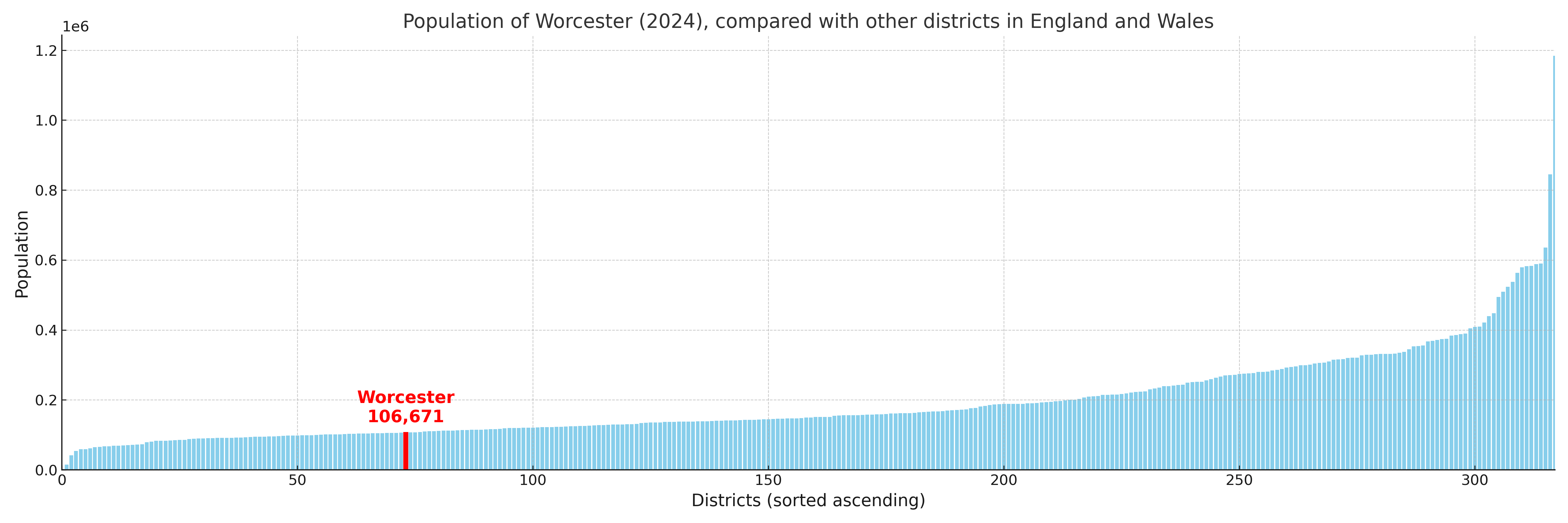Worcester
§ This page gives an overview of the Worcester local authority district, bringing together key facts, maps, and data to help you quickly understand the area. One of 361 district profiles on Baseview.
Overview ⁞ Worcester, on the River Severn, is a historic cathedral city with a rich heritage and riverside setting. Worcester Cathedral dominates the skyline, while the city centre combines medieval streets, Georgian buildings, and modern shopping areas. The Severn provides scenic riverside walks and parks, with Diglis Basin and Worcester Racecourse adding leisure spaces. Surrounding countryside includes farmland, villages, and historic estates, making Worcester a district that blends heritage, riverside charm, and rural surroundings.
Worcester Boundary Map
This map shows the official boundary of the Worcester local authority district, based on the latest geographic data published by the Office for National Statistics (ONS). It provides a clear view of the district’s extent and helps you understand how the area fits within the wider regional and national landscape.
Contains OS data © Crown copyright and database right 2025. Source: Office for National Statistics licensed under the Open Government Licence v3.0.
The administrative boundary of Worcester can also be viewed on OpenStreetMap: District Boundary of Worcester.
Key Facts about Worcester
What region is Worcester in? Worcester is in the West Midlands of England, a region within the UK.
What county is Worcester in? Worcester is located in the county of Worcestershire.
Is Worcester a city? Yes, Worcester is a city. Worcester holds official city status as one of the 76 designated cities in the UK.
Who governs Worcester? The local authority for this district is: Worcester City Council - responsible for district-level services. Since Worcestershire is a two-tier area, county-level services are handled by: Worcestershire County Council.
▶ Official website of Worcester City Council 🔗 worcester.gov.uk

Which police force covers Worcester? Policing in Worcester is provided by West Mercia Police 🔗 westmercia.police.uk, which serves 9 local authority districts: Bromsgrove ⁞ Herefordshire, County of ⁞ Malvern Hills ⁞ Redditch ⁞ Shropshire ⁞ Telford and Wrekin ⁞ Worcester ⁞ Wychavon ⁞ Wyre Forest.
Worcester in International Geographies
In the International Territorial Levels (ITLs) hierarchy, Worcester is within one of ITLs Level 2 area, Herefordshire, Worcestershire and Warwickshire, that contains the following 3 ITLs Level 3 areas:
(ITL 1) West Midlands
(ITL 2) ⇒ Herefordshire, Worcestershire and Warwickshire
(ITL 3) ⇒⇒ Herefordshire, County of ⁞ Worcestershire CC ⁞ Warwickshire CC
The International Territorial Levels are used by OECD member countries for statistical purposes to classify administrative areas. We have this listable page for easy browsing of ITL names and codes: International Territorial Levels.
Constituencies in Worcester
Worcester is divided into 1 parliamentary constituencies, listed below in alphabetical order.
A constituency is a specific geographical area that elects one Member of Parliament (MP) to represent them in the House of Commons. The United Kingdom is divided into 650 parliamentary constituencies. We have this list page for easy browsing of all UK parliamentary constituencies: List of Constituencies.
Wards in Worcester
Worcester is divided into 16 wards, listed below in alphabetical order.
- Arboretum
- Battenhall
- Cathedral
- Claines
- Dines Green & Grove Farm
- Fort Royal
- Leopard Hill
- Lower Wick & Pitmaston
- Nunnery
- Rainbow Hill
- St Clement
- St John's
- St Nicholas
- St Peter's Parish
- St Stephen
- Warndon & Elbury Park
In the UK, a ward is a subdivision of a local authority area, used mainly for electoral and statistical purposes. Defined by the ONS, wards represent the primary unit for local elections, each returning one or more councillors to the local council. Wards are also used as a key geography for presenting population and census data.
Parishes in Worcester
Worcester is part-parished: 2 civil parishes (listed A-Z below) alongside 2 unparished areas.
- St. Peter the Great County
- Warndon
A civil parish is the lowest tier of local government in England, used for villages, small towns, and suburbs. They have their own local authority, either a parish council or a parish meeting, which provides local services like managing parks, allotments, and streetlights, and represents the community's views to larger councils.
Built-up Areas in Worcester
Worcester covers 4 built-up areas, listed below in alphabetical order.
- Fernhill Heath *
- Rushwick *
- Whittington (Wychavon) *
- Worcester *
In the UK, a Built-up Area (BUA) is a continuous urban area of at least 20 hectares (0.2 km²), defined by the ONS as land where buildings are generally no more than 200 metres apart, such as towns, cities, or large villages. (Note: A BUA name marked with an asterisk (*) indicates that the area is situated partly in the district of Worcester.)
Worcester compared with other districts in the UK
This section shows how Worcester compares with other local authority districts in the UK, using a variety of measures and rankings.
Worcester has 16 electoral wards.

Worcester has a population of 106,671 (2024 mid-year estimate by ONS)

More local statistics and data for Worcester can be found on the ONS statistics for Worcester.